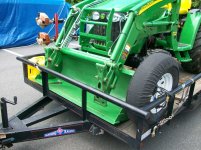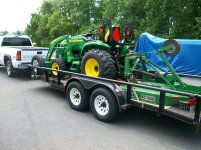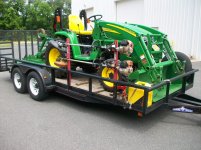LHS Inc
Gold Member
- Joined
- Nov 16, 2010
- Messages
- 357
- Location
- Eastern Shore, Maryland
- Tractor
- JD 3520 eHydro w/300CX FEL
I've been loading my JD 3520 w/FEL and Frontier RC1060 on my 18 ft 10,000 lb trailer for a monthly bushhogging job for a commercial client.
As you can see by my pics I can get the whole rig on the trailer by dropping the bucket and lifting the tailwheel on the cutter with about six inches to spare.
My situation is by driving on there seems to be too much weight on the front and with backing on too much in the back. I can't find a happy medium.
Not having the the FEL w/bucket isn't an option due to some slope I have to cut on this site because I feel it adds some stability.
If I have to spend some money at the end of the year for tax purposes I was thinking about getting a 20 ft trailer.
My question is would an extra two feet make enough difference in the weight distribution.
I'm not sure where the tipping point is in either direction so the next time I load it on I could drive it to certain points on the trailer to see just where that is. Then I would know if two more feet will do anything for me.
Until then I'll take any input on the matter.
As you can see by my pics I can get the whole rig on the trailer by dropping the bucket and lifting the tailwheel on the cutter with about six inches to spare.
My situation is by driving on there seems to be too much weight on the front and with backing on too much in the back. I can't find a happy medium.
Not having the the FEL w/bucket isn't an option due to some slope I have to cut on this site because I feel it adds some stability.
If I have to spend some money at the end of the year for tax purposes I was thinking about getting a 20 ft trailer.
My question is would an extra two feet make enough difference in the weight distribution.
I'm not sure where the tipping point is in either direction so the next time I load it on I could drive it to certain points on the trailer to see just where that is. Then I would know if two more feet will do anything for me.
Until then I'll take any input on the matter.


